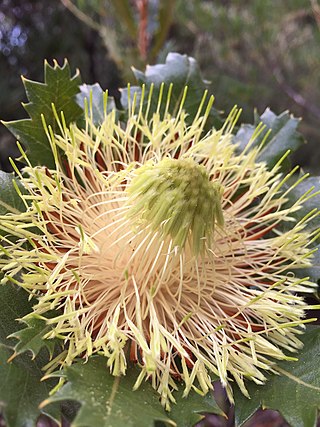
Banksia heliantha, commonly known as oak-leaved dryandra, is a species of shrub that is endemic to Western Australia. It has hairy stems, serrated, egg-shaped to wedge-shaped leaves, golden yellow flowers and partly woolly follicles.

Chorilaena quercifolia, commonly known as karri oak or chorilaena, is a species of bushy shrub that is endemic to the karri forests of south-west Western Australia. It is the sole species in the genus Chorilaena. It has papery, broadly egg-shaped leaves with lobed edges and variously-coloured flowers arranged in umbels of five, the sepals and petals hairy on the outside and the stamens protruding beyond the petals.

Thomasia tenuivestita is a species of flowering plant in the family Malvaceae and is endemic to the south-west of Western Australia. It is a shrub with its new growth covered with greyish, star-shaped hairs, and has egg-shaped leaves, and racemes of mauve flowers.

Thomasia purpurea is a small, flowering shrub in the family Malvaceae that is endemic to the southwest of Western Australia. It has green oblong-shaped leaves and pinkish purple flowers.

Guichenotia ledifolia is a species of flowering plant in the family Malvaceae and is endemic to the southwest of Western Australia. It is a densely-branched shrub with densely hairy new growth, hairy, linear to oblong leaves and pink to mauve flowers arranged in groups of three to ten.

Guichenotia macrantha, commonly known as large-flowered guichenotia, is a species of flowering plant in the family Malvaceae. It is a shrub with grey-green leaves, mauve flowers and is endemic to Western Australia.

Seringia hermanniifolia, commonly known as crinkle-leaved firebush, is a species of flowering plant in the mallow family and is endemic to the south-west of Western Australia. It is a low-growing or prostrate, suckering shrub with hairy new growth, hairy, wavy, oblong to egg-shaped leaves and mauve to bluish flowers arranged in groups of 3 to 8.

Pityrodia ternifolia is a species of flowering plant in the mint family, Lamiaceae and is endemic to north-western Australia. It is an erect shrub with densely hairy stems, sticky and prickly, egg-shaped leaves, and mauve or pinkish-red, tube-shaped flowers.

Thomasia angustifolia, commonly known as narrow-leaved thomasia, is a species of flowering plant in the family Malvaceae and is endemic to the south-west of Western Australia. It has densely hairy young stems, narrowly oblong, wrinkled leaves and pinkish-purple, bell-shaped flowers.
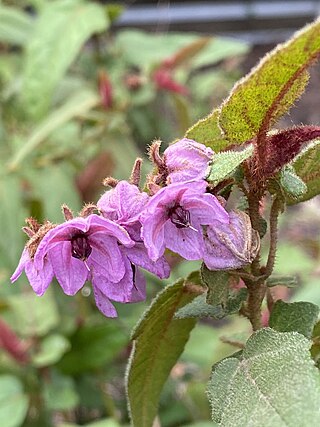
Thomasia paniculata is a species of flowering plant in the family Malvaceae and is endemic to the south-west of Western Australia. It is a spreading shrub with heart-shaped to narrowly egg-shaped leaves and pinkish-mauve flowers.

Thomasia brachystachys is a species of flowering plant in the family Malvaceae and is endemic to the Southwest Australia south-west of Western Australia. It is an open, erect shrub with egg-shaped to heart-shaped leaves and pink to mauve flowers.
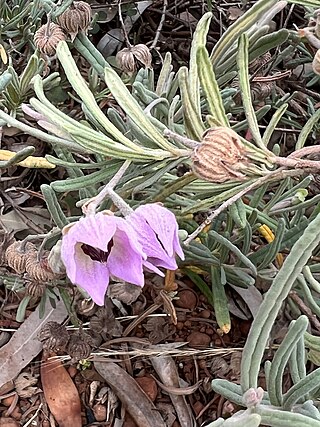
Guichenotia intermedia is a flowering plant in the family Malvaceae and is endemic to Western Australia. It is a small shrub with hairy leaves and mauve-pink flowers.
Thomasia × formosa is a species of flowering plant in the family Malvaceae and is endemic to a restricted area of the south-west of Western Australia. It is an erect, compact shrub with densely hairy branchlets, hairy, coarsely serrated, egg-shaped to elliptic or oblong leaves, and racemes of pink or purple flowers arranged in leaf axils.
Thomasia glabripetala is a species of flowering plant in the family Malvaceae and is endemic to a restricted area of the south-west of Western Australia. It is an open shrub with densely hairy branchlets, sparsely hairy, wrinkled, elliptic or oblong leaves, and racemes of purplish-pink flowers arranged in leaf axils.
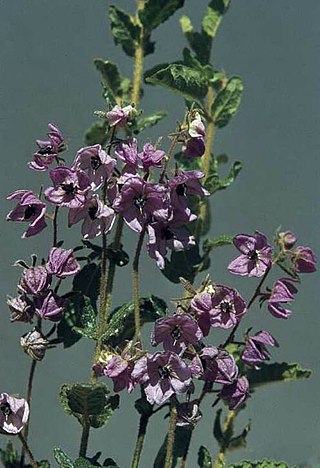
Thomasia macrocalyx is a species of flowering plant in the family Malvaceae and is endemic to the south-west of Western Australia. It is an erect, bushy shrub with densely hairy new growth, egg-shaped leaves with a heart-shaped base and lobed or toothed edges, and groups of pale purple to mauve or white flowers.
Thomasia multiflora is a species of flowering plant in the family Malvaceae and is endemic to the south-west of Western Australia. It is a low, spreading shrub with broadly egg-shaped leaves and mauve flowers.
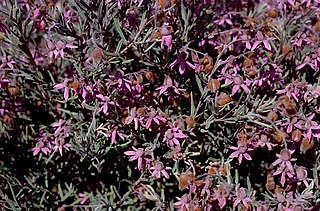
Thomasia rugosa, commonly known as wrinkled leaf thomasia, is a species of flowering plant in the family Malvaceae and is endemic to the south-west of Western Australia. It has wrinkled, lance-shaped to egg-shaped leaves with wavy edges, and pink to mauve flowers.
Thomasia tremandroides is a species of flowering plant in the family Malvaceae and is endemic to the south-west of Western Australia. It is an erect or low, spreading shrub with many stems, flimsy, papery, egg-shaped leaves and racemes of papery, mauve to pink flowers.
Commersonia rotundifolia, commonly known as round-leaved rulingia, is a species of flowering plant in the family Malvaceae and endemic to the south-west of Western Australia. It is an upright, openly-branched shrub with elliptic to round leaves with wavy edges, and white flowers in clusters of 3 to 10.

Guichenotia angustifolia is a species of flowering plant in the family Malvaceae and is endemic to the south-west of Western Australia. It is an erect, prostrate or climbing shrub with hairy young growth, hairy, oblong to linear leaves and pink to mauve flowers.


















